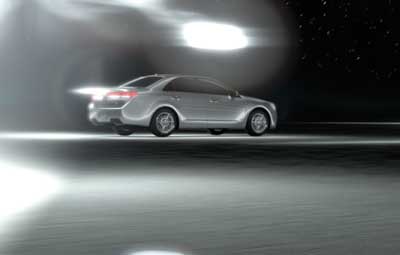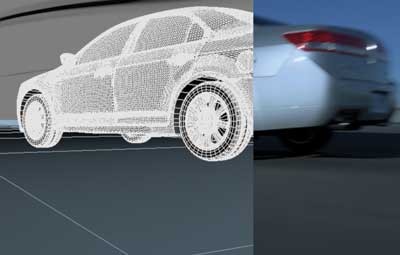How Digital Domain Took a Live-Action Shoot All Digital
The live action was a two-day shoot. One was the live action shoot of the car and that was done with a chase camera. The second day was on the stage for all the effects shots and the car interior. For the car interior we used motion control because the idea was that we would use several passes of the interior with these practical light effects and then mix them together, but that never happened.
People have got used to the digital production process where post is not post anymore. We’ve done these types of projects where if you keep it open in terms of the effects and it is talked about only in vague terms then what you shoot may not be what you want when you finally get in post. Everyone from the agencies and the production companies like to make decisions as they are sitting there in compositing suites. If you are able to use what you shot then great. But if you don’t keep things open in the shooting process you won’t have the option to change things in post.
We experimented a lot. We worked on this for over six weeks. But for the first four weeks we were experimenting with other things: blue fire, cellophane asteroids that chase the car and other renditions. It was three-quarters through our own schedule that we settled on the white straight lasers. It’s just part of the process now. It’s less and less of an option to make creatives decide what they want while they are shooting. People want the option of changing their mind and we allow them to do that.

Yes and no. The idea was that the car is driving around and there are a lot of light effects around the car. We did use a lot of the stuff we shot but it wasn’t used directly. We have a mad scientist way of making effects. We would input the film that [director] Carl [Erik Rinsch] shot and use that to drive the 3D effects. You can always use the effects that were shot in-camera. At a minimum you can use it as reference. None of it was applied directly in the composite but a lot of it can be used as input information All of the effects are largely scripted. Having scanned film and that color information driving the effects is always an option and we did that in certain places. But mostly they are digital effects.
The car in the commercial is all digital too, correct?
The car is all digital. We tracked the live-action car so we had a real mile-per hour gauge, so we tell the effects going around it to go at the same speed, or some variation of it whether you wanted them to overtake the car, lag behind or crawl around the shell of the car.

We rendered a series of passes of the 3D car, a beauty pass, an effects/reflection pass, a shadow pass an occlusion pass, etc. Then we would bring those renders in and build the car. Then, if needed, we would bring the live-action car in and grade it so it was in the same color space and kick that in as well. About half the car shots have some live action mixed in. Not much, but some. Sometimes there are little details in photography, little pings of light or whatever that may add to the digital version of the car. There’s a certain way that light reacts to film that you just can’t get otherwise.

But creating CG cars is old-hat for you guys.
We’ve been doing cars for a while now. It really doesn’t fall into the category of software as just know-how. The biggest challenge of this show was that there were just so many shots. It was a 30 second commercial with 23 shots and every one of them was and effects shot.
Were you creating the light effects to work with the sound?
No. One thing that was challenging was that when we delivered there was no audio, so we worked totally blind. We’re used to having at least a temp track. We had to deliver it without ever hearing any sound. We just saw the finished commercial with the sound a couple days ago and were really pleased with it.
How was the opening shot of the meteor created?
That was done in Houdini using Storm, our proprietary volumetrics tool. We had a simple geometry animated that we cascade off the origin and did a volumetric fill where we had stuff emanating from this, then the renderer would render it as a density pass without any lighting and then in the composite we would turn that into a glowing object.
Did you enjoy this article? Sign up to receive the StudioDaily Fix eletter containing the latest stories, including news, videos, interviews, reviews and more.










Leave a Reply